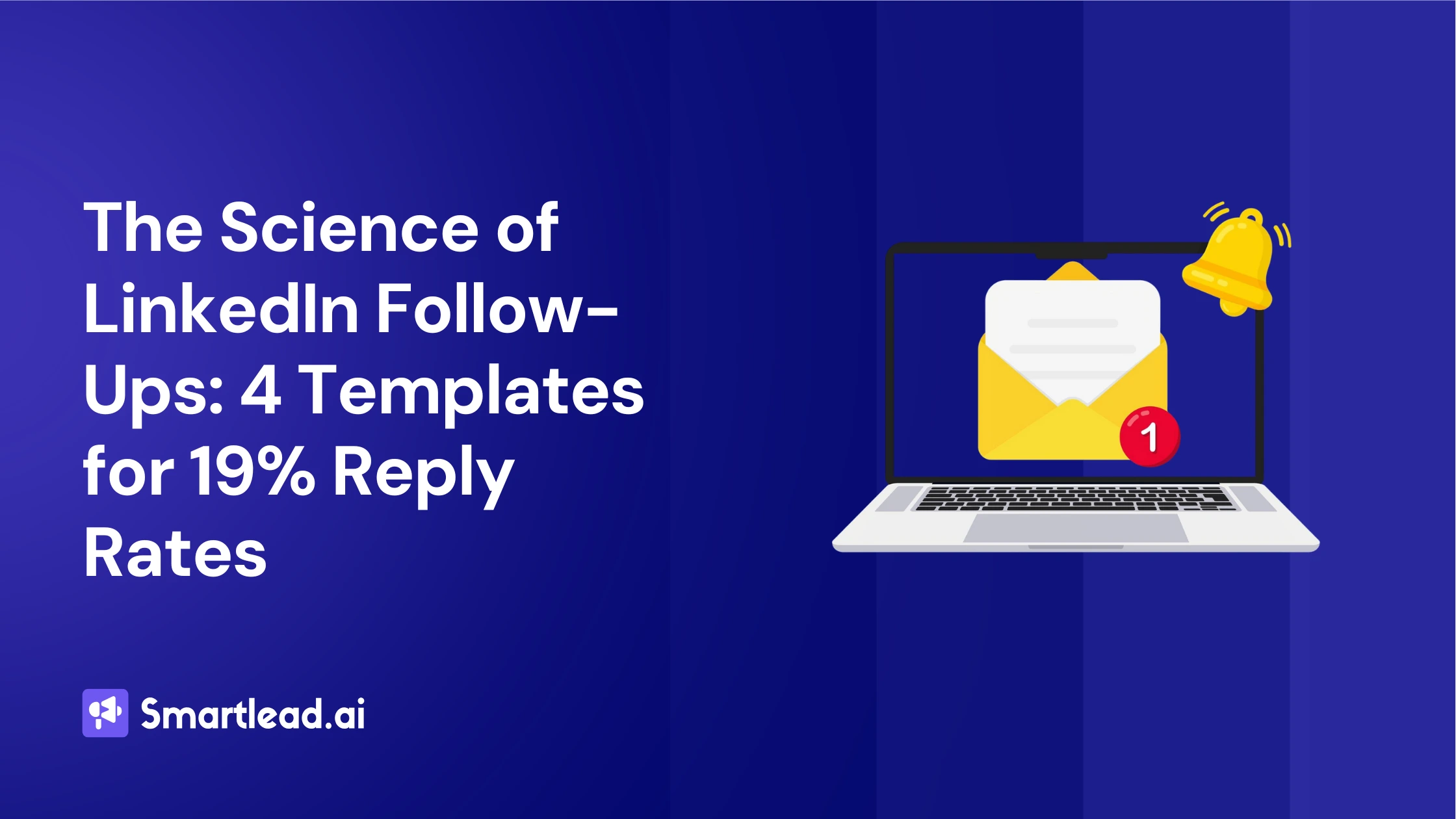The Science of LinkedIn Follow-Ups: 4 Templates for 19% Reply Rates

The Science of LinkedIn Follow-Ups: 4 Templates for 19% Reply Rates
Are you looking for the perfect LinkedIn follow-up message?
I’ll share how we write LinkedIn follow-up messages that bring our clients 19.7% reply rates on average
You’ll see, the secret to this has to do with 3 things:
Leading with Value, personalization, research, and something mathematicians call the “Fibonacci sequence”
In this article, we’ll share our top tips for following up with prospects in a way that feels genuine and not pushy, as well as 5 templates for 19% reply rates.
The importance of following up on LinkedIn the right way
There is a very fine balance...
If you do not follow up, it is very clear that your reply rates will suffer.
On the other end of the spectrum, if you follow up too aggressively, you're just going to annoy prospects. This approach will not yield any leads or sales from your LinkedIn outreach efforts.
So you need to consider:
- How many times should you follow up on LinkedIn?
- What frequency should you follow up? (How much time in between messages?)
- What should each follow-up say?
We are going to break this down for you below.
How many times should you follow up on LinkedIn?
If you're skilled at sales outreach, you know it's possible to follow up five or more times without being annoying, and more importantly, without repeating yourself.
That might sound like a lot, but don’t worry.
Even aiming for just 3 well-written, genuinely interested follow-ups can make a big difference, especially on LinkedIn.
Why three?
Because of the 80/20 principle. Roughly 80% of responses come within the first three follow-ups.
So if you're new to outreach, start there.
It's the sweet spot for staying persistent without coming off as pushy.
If you are really comfortable with follow-ups, you can send 5.
Being concrete, those who are experienced with LinkedIn lead generation can send shorter messages that feel very conversational and personalized.
Therefore, they are able to send 5 and beyond messages without it feeling like overkill. But if you're new to LinkedIn outreach, just aim for 3 really good follow-ups.
What frequency of LinkedIn message follow-ups should you follow?

We suggest using the Fibonacci sequence for effective follow-ups.
The Fibonacci sequence is a pattern where each number is the sum of the two before it.
So it goes:
1, 1, 2, 3, 5, 8, 13... and so on.
Now, why does this matter in sales?
Because this sequence gives us a natural, non-pushy rhythm for following up. Instead of bombarding your prospect every day or disappearing for weeks, you use the sequence to space out your messages.
Here’s how that might look in practice:
- Day 1 – First message
- Day 2 – Initial follow-up message
- Day 4 – Follow-up number 2
- Day 7 – Follow-up number 3
- Day 12 – Follow-up number 4
- Day 20 – Follow-up number 5
See how the spacing gradually increases?
It feels more natural and respectful of your prospect’s time. You stay on their radar without overwhelming them.
This will stop you from looking desperate or spammy and gives your prospect space to respond. It’s a simple but surprisingly effective way to bring some science (and kindness) into your follow-up strategy.
Just remember, the more value and personalization you include in your messages, the harder it becomes for prospects to ignore or decline your offer.
If your messages show genuine interest, you will be able to send more follow-ups and probably become a bit more aggressive with the timing.
Just bear in mind that we have learned that the shorter your delays in follow-ups, the higher the response rate. The data does not indicate that it's always a higher positive reply rate.
If you send messages too frequently, yes, you're likely to get a higher response rate, but many of those replies will be negative.
What should you say in each follow-up?
This is probably the biggest and most important insight in this whole post.
You must NOT repeat yourself in a follow-up message… EVER.
Every follow-up is an opportunity to bring something new to the sales conversation. There are so many salespeople who send messages, and they just don't educate the prospect or bring something new to the conversation.
Experts ensure that the call to action and the offer in each message are updated.
For example, if you invite them to a sales call in your first message, and they don't respond to that, don't invite them to a sales call in your second message.
Instead…
Try to get them to look at a case study video where you solved a similar pain point that they might be experiencing.
And message three could be a bit of a down-sell. You could even invite them to follow your company's LinkedIn or subscribe to your newsletter.
The point is, you need to change your CTA with every follow-up message you send to get the best response.
Follow-up LinkedIn message templates
Template #1:
{firstName}, not sure if you’re running into this, but the {jobTitle} at {clientName #1} used to deal with {painPoint #1} when they didn’t have a way to {benefit #1}.
How are you dealing with this on your end?
Template #2:
{firstName}, Probably should have shared how {clientName} saw {benefit #2} without {objection} in {timeFrame}:
{caseStudyLink}
Think {company} could use this to avoid {painPoint #2}?
Template #3:
Made a short video walking through a few practical strategies for {solution}.
It’s under 5 minutes and shows you {benefit #3}, even if you’re {objection #3}. Should be especially helpful since {relevant detail on Company/Person}.
Is it a bad idea to share the video link?
Template #4:
Hey {firstName},
Even if you’re all set when it comes to {painPointOrBenefit}, we publish {contentType} with {contentTeaser} for 10k {targetAudience}.
Open to {engagementAction} so we can stay in touch?
Tips for writing outreach messages that get replies
Always use personalization
If your messages aren't personalized, you won't receive many positive replies.
So do your research.
Understand your prospects' pain points and review their LinkedIn profiles.
Is there anything that you can use to either:
- Compliment them on?
- Mention a commonality?
- Or a question you could ask?
For example, if you notice that they were interviewed on a podcast, listen to the podcast and find something specific that resonated with you, and mention it in your message.
This will set you apart from every other SDR on the platform. Just remember to keep the conversation natural. You don't want to compliment them in every message. That will come across as odd.
Keep your messages short
Imagine that you only have 2 or 3 sentences to build trust and credibility, mention pain points, and ask to take the next step.
This is a good framework for writing follow-up messages, and as follow-ups go on, you actually want to keep them shorter.
Messages with fewer words have higher reply rates.
Make it easy for your prospect to engage by keeping the follow-up message short.
Don't be afraid to ask for a sales meeting or a booked call
Asking for a sales call should be part of at least one of your messages.
Typically, you would want to set up a pain or frustration that you know your prospects are dealing with and invite them to a call to talk through their challenges further. Here, you can share insights on how to relieve that pain.
This should be a pretty natural progression.
And you shouldn't feel ashamed for asking for a call. You should position that follow-up so that it's crystal clear why it's in their best interests to hop on a call with you. When you set the call up in that way, it's like you're saying, “Allow me to help you with this.”
These thoughtful, helpful, and genuine messages should be the underlying tone of all your outreach.
Use automation, but not for everything
You can use automation to streamline your follow-up process, but don't use automation for every single step. Get your SDRs to reply in real time to queries. This will show that you actually care and that there's not just a robot on the other side of your prospect's screen.
The worst thing is if a prospect asks a specific question, and all they receive is an automated message that doesn't answer them correctly.
Don't just use LinkedIn, try following up on email, too
We know this post is all about LinkedIn follow-ups, but I'm sure you can imagine a scenario where you would want to follow up using other channels.
For example, you could also try reaching out to potential clients through email outreach, and maybe even use a phone step. A LinkedIn email finder can make this process easier by providing accurate email addresses, allowing you to follow up effectively with potential clients beyond LinkedIn.
This is something you should consider if you're looking for maximum results from your outreach campaigns.
Should you follow up with an InMail?
InMail should be viewed as a last resort. If you send a connection request, and the prospect doesn't connect, you should try to send an InMail. It can still play a role in your outreach success.
But bear in mind that if your prospect is not active on LinkedIn, InMail is probably not going to work; If this is the case, you may need to dig up their email address and email them.
What's a good gauge of whether your techniques are working?
At SalesBread, our average reply rate is 19%, of which roughly half come from follow-ups. Therefore, we suggest aiming for 10% replies on your follow-up messages.
Final Thoughts
Following up on LinkedIn doesn’t have to feel awkward or pushy.
When you focus on offering real value, personalizing your message, and spacing your outreach with care, you build trust instead of resistance.
Start with just a few thoughtful follow-ups, experiment with what feels authentic, and remember: it’s about starting conversations.
Your next great client might just be one follow-up away.



.svg)